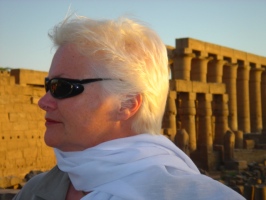Marie Antoinette (pictured in marble above) was Queen of France from 1770 to 1793. She was beheaded on October 16 by guillotine in the present Place de la Concorde. And she apparently never did say, “Let them eat cake.”
Her husband, Louis XVI (pictured below), had been beheaded in January, nine months before her, during the height of the Revolutionary excesses of the revolution. A golden plaque at Place de la Concorde records the deed and the place.

Â
Louis and Marie’s 8-year-old son Louis-Charles (shown below) had been taken from Marie Antoinette in July and given over to the care of a carpenter. The boy died two years later. As was a custom of the time, Louis-Charles’s heart was taken from his body and preserved. For over 200 years stories had circulated that the boy who had died was not Louis-Charles but a substitute, that the heart was not his, and that Louis Charles had escaped and died in the Netherlands at the age of 60.
Scientists have since proved that Louis-Charles (Louis XVII) did indeed die in a Parisian prison. Tests were recently carried out by Belgian and German experts to compare DNA from his heart with DNA taken from hairs from the head of Marie Antoinette and the heads of her relatives and their descendants. There was no description I could find about how all these hairs were gathered.
But back to Marie. Following her arrest in 1793, she was eventually taken to La Concergerie (pictured below), a creepy old behemoth of a building on the south side of the Seine. Tourists can see the cell where she was kept (now converted into a chapel) along with their ticket to the charming Sainte-Chapelle.
After Marie-Antoinette’s execution (pictured in a contemporary illustration below), her body was thrown into a common grave. In 1806, her supposed remains were taken to the cemetery of the Madeleine Church and stayed there with her husband Louis’s bones for 21 years.

Louis XVIII then tranferred their remains (bits and pieces and a leg garter, according to one account) from that gravesite to the crypts in the St. Denis Cathedral. That original resting place for Louis and Marie Antoinette was made into La Chapelle Expiatoire (Chapel of Atonement), somewhat somber on the rain-washed evening I visited it.
Black stone vault covers (shown below) at St. Denis were replaced the deteriorating stone ones in the 1970s. When I visited, someone had left a bouquet of red roses next to Marie Antoinette’s tomb.

The stone, low light, and cold make St. Denis the perfect resting place. The cathedral itself is well kept, active, and looked down upon a large street market while I was there.
The beheaded queen and her mobile remains get a bad rap with the infamous “let them eat cake” remark. Apparently she never did say, Qu’ils mangent de la brioche. Jean-Jacques Rousseau comments that a “certain princess” said it, presumably Louis XIV’s queen, Maria Theresa of Spain (pictured below).
Maria Theresa was supposed to have said, S’il ait aucun pain, donnez-leur la croûte au loin du pâté, “If there be no bread, give them the crust off of the pâté”. In truth is it not known if she–or any other French queen–actually ever said this. Let them all rest in peace.






One Comment